Share Files or Folders in Office 365 (External Only)
Intended for:
Office 365 users.
Scenario/Use case:
- Share files or folders in Microsoft 365 OneDrive Externally (No Services Account Required).
- Get a link to a file or folder that you can copy.
- See who a file or folder is shared with.
- Levels of sharing access.
Instructions:
Share files or folders in Microsoft 365 OneDrive Externally (No Services Account Required)
Share a file or folder
With a file open or a file or folder selected, select Share:
- If you are working on your desktop and the file hasn’t been saved to OneDrive or SharePoint, select a location you want to upload your file.
- Select the down arrow to choose permissions for the link you will be sharing. Options include:
- Anyone (if your organization allows it)
- People in your organization
- Specific people
- Select Apply to save the permissions.
- Enter the name or email address of people you want to share with.
- Type a message.
- Select Send.
Or, you can select Copy Link and send the link in an email or add it to a file.
Share a file or folder
Here's how you share files or folders in SharePoint:
Select the file or folder you want to share, and then select Share.
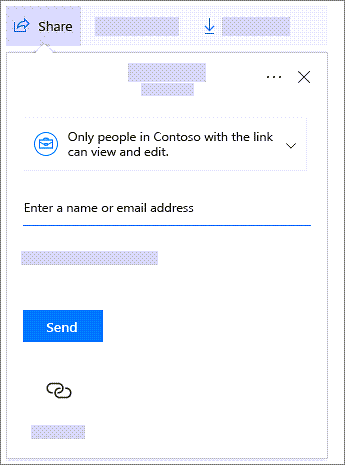
(Optional) Select the dropdown list to change the type of link. The Details pane opens, where you can change who can access the link and whether people can edit the item you’re sharing.
Options for Who would you like this link to work for (options vary based on admin settings):
- Anyone gives access to anyone who receives this link, whether they receive it directly from you or forwarded from someone else. This may include people outside of your organization.
Note: This option is not available in SharePoint Server 2019. - People in <Your Organization> gives anyone in your organization who has the link access to the file, whether they receive it directly from you or forwarded from someone else.
- People with existing access can be used by people who already have access to the document or folder. Use this if you just want to send a link to somebody who already has access.
- Specific people gives access only to the people you specify, although other people may already have access. If people forward the sharing invitation, only people who already have access to the item will be able to use the link.
Note: If a sharing option has been greyed out, your organization's admins may have restricted them. For example, they may choose to disable the Anyone option to prevent usable links being forwarded to others.
By default, Allow editing is turned on. If you want people to only view your files, uncheck the check box.
When you're done, select Apply.
Enter the names of the people you want to share with and a message, if you want.
When you’re ready to send the link, select Send.
Get a link to a file or folder that you can copy
Another way to share is to get a link to a file or folder that you can copy and paste in a text message or on a website. People you share these links with can also forward your link to others.
In SharePoint, select Copy link. The link is automatically copied to your clipboard.
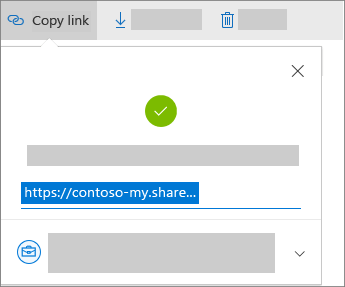
(Optional) Select the dropdown list to change the type of link. The Details pane opens, where you can change who can access the link and whether people can edit the item you’re sharing.
Options for Who would you like this link to work for (options vary based on admin settings):
- Anyone gives access to anyone who receives this link, whether they receive it directly from you or forwarded from someone else. This may include people outside of your organization.
- People in <Your Organization> gives anyone in your organization who has the link access to the file, whether they receive it directly from you or forwarded from someone else.
- People with existing access can be used by people who already have access to the document or folder. It does not change the permissions on the item. Use this if you just want to send a link to somebody who already has access.
- Specific people gives access only to the people you specify, although other people may already have access. If people forward the sharing invitation, only people who already have access to the item will be able to use the link.
By default, Allow editing is turned on. If you want people to only view your files, uncheck the check box. This can be further restricted by selecting the option to Block download, which means they cannot save a local copy.
When you're done, select Apply.
Paste the link (Ctrl+V) wherever you want, such as a text message or on a website.
Notes:
- The permission granted by a sharing link lasts only as long as the link exists. For example, when a link is disabled, access is revoked (though people may still have access to the file via other means).
- When Allow editing is selected: After they sign in, people in your organization can edit, copy, or download the files. When Allow editing isn’t selected, people in your organization can view, and may be able to copy or download the files.
- Site administrators can restrict sharing so that only owners can share files and sites.
- If site administrators have not restricted sharing to site owners, any person with Edit permissions to a file or folder can share that file or folder with others by selecting Share or Copy link. People who don't have edit permissions can use Copy link to get a link that will work for people who already have permissions to the file or folder.
- The option to create or open "Anyone" links to .aspx pages is not supported.
See who a file or folder is shared with
Select the file.
Click the Information icon  in the upper right to open the Details pane.
in the upper right to open the Details pane.
Click Manage Access.
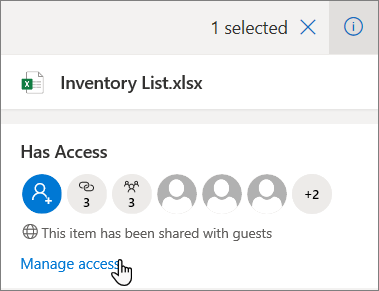
The Manage Access panel opens:
- The Links Giving Access section shows the links that have permissions to the file or folder. Click the ellipsis (...) to see the users that the link has been shared with.
- The Direct Access section shows people and groups who have direct access to the file or folder. (This includes groups that have access to the site where the file or folder resides.)
- When viewing who has access to a file or folder, internal users will have their name and job title displayed. External users will only have their email address displayed, with External User below the address.
Levels of sharing access
There are different options for sharing:
- Anyone gives access to anyone who receives this link, whether they receive it directly from you or forwarded from someone else. This may include people outside of your organization.
- People in <Your Organization> gives anyone in your organization who has the link access to the file, whether they receive it directly from you or forwarded from someone else.
- People with existing access can be used by people who already have access to the document or folder. It does not change the permissions on the item. Use this if you just want to send a link to somebody who already has access.
- Specific people gives access only to the people you specify, although other people may already have access. If people forward the sharing invitation, only people who already have access to the item will be able to use the link.
Note: If a sharing option has been greyed out, your organization's admins may have restricted them. For example, they may choose to disable the Anyone option to prevent usable links being forwarded to others.
There are also different levels of permission:
- Can view allows the recipient to only view the file or folder; they cannot make changes to it. This can be further restricted by selecting the option to Block download, which means they cannot save a local copy.
- Can edit allows the recipient to make changes to the file or folder.
Additionally, when creating a link, you can set an expiration date, as well as a password to access the file. (You will need to provide the password to the person or people you're sharing the file with.)
Through the Manage Access panel, you can also stop sharing OneDrive or SharePoint files or folders, or change permissions.
Stop or change sharing
Files and folders can be shared by sending someone a sharing link, or by giving them direct access to the file or folder. (People may also have access to a file or folder if they've been given access to the site itself.)
If you are the file owner, you can stop sharing the file or folder.
If someone has been given direct access, or has access through a specific people link, you can also change the sharing permissions between view and edit.
Here are the steps:
- Select the file or folder you want to stop sharing.
- Select Information
 in the upper-right corner to open the Details pane.
in the upper-right corner to open the Details pane.
Note: (The Information icon is just below your profile picture. If you don't see it, make sure you only have one file or folder selected - it won't display if you have multiple items selected.) - On the Details pane, under the Has Access header, you'll see the People icon, the Links icon, and/or the Email icon. These options vary depending on how you have shared the file or folder.
- Select Manage access and to stop sharing the file entirely, click Stop sharing.
- To delete a sharing link, click the ... next to the link, then click the X next to the link to remove it. (You'll get a prompt asking you if you're sure you want to delete the link - if so, click Delete link.)
- To stop sharing with specific people, expand the list under a specific people link and click the X to remove someone.
- To change permissions or stop sharing with someone who has direct access, under Direct Access, click the dropdown next to the person's name and choose the option that you want.
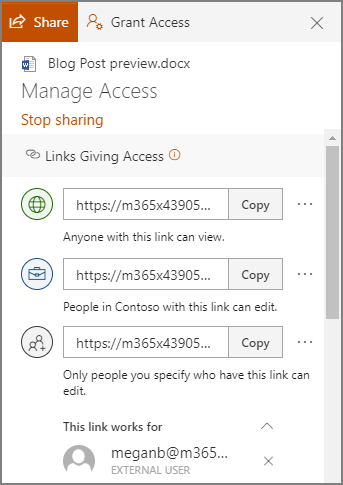
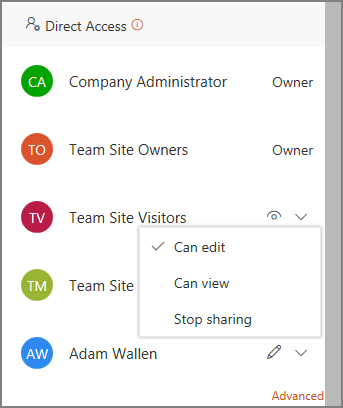
Tip: You can also manage a file or folder's sharing permissions through the OneDrive desktop app for Windows 7, Windows 10, and Mac. All you need to do is right-click the shared file or folder in your OneDrive folder on your computer, and select Share, then select More  > Manage access, and a dialog box will open on your desktop so you can make your selections as described above in step 3.
> Manage access, and a dialog box will open on your desktop so you can make your selections as described above in step 3.
See the items you've shared
On OneDrive.com, select Shared in the left pane, and then select Shared by me.